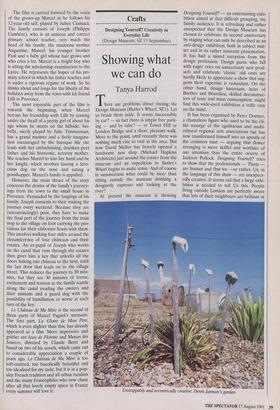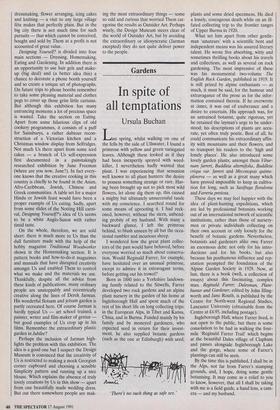Crafts
Designing Yourself? Creativity in Everyday Life (Design Museum, till 15 September)
Showing what we can do
Tanya Harrod
There are problems about visiting the Design Museum (Butler's Wharf, SE1). Let us brush them aside. It seems inaccessible by car? — in fact there is ample free park- ing — and by tube? — to Tower Hill or London Bridge and a short, pleasant walk. More to the point, until recently there was nothing much else to visit in the area. But now David Mellor has bravely opened a handsome new shop (Michael Hopkins Architects) just around the corner from the museum and an expedition to Butler's Wharf begins to make sense. And of course in summertime what could be nicer than sitting outside the museum drinking a designerly espresso and looking at the river?
At present the museum is showing
Designing Yourself? — an entertaining exhi- bition aimed at that difficult grouping, the family audience. It is refreshing and rather unexpected that the Design Museum has chosen to celebrate its second anniversary by staging what can only be described as an anti-design exhibition, both in subject mat- ter and in its rather innocent presentation. It has had a mixed reception from the design profession. Design gurus who fall with eager cries on unnecessary new prod- ucts and celebrate 'classic' old ones are hardly likely to appreciate a show that sug- gests their expertise is redundant. On the other hand, design historians, heirs of Barthes and Bourdieu, skilled deconstruc- tors of taste and mass consumption, might find this wide-eyed exhibition a trifle easy on the mind.
It has been organised by Peter Dormer, a chameleon figure who used to be the eli- tist scourge of the egalitarian and multi- cultural regional arts associations but has now transformed himself into an apostle of the common man — arguing that flower arranging is more skilful and worthier of our attention than the entire oeuvre of Jackson Pollock. Designing Yourself? tries. to show that the professionals — Them — are human and that we —or rather, Us, in the language of this show — are unexpect- edly creative. It seems sad that a large exhi- bition is needed to tell Us this. People living outside London are perfectly aware that lots of their neighbours are brilliant at Unstoppably and eccentrically creative: Derek Jarman's garden dressmaking, flower arranging, icing cakes and knitting — a visit to any large village fête makes that perfectly plain. But in the big city there is not much time for such pursuits — that which cannot be conceived, bought and sold by Them at a profit is not accounted of great value.
, Designing Yourself? is divided into four main sections — Dressing, Homemaking, Eating and Gardening. In addition there is an opportunity to use hair gels and make- up (big deal) and (a better idea this) a chance to decorate a phone booth yourself and so create a unique set of photographs. On future trips to phone booths remember to take some pleasing material and clothes pegs to cover up those grim little curtains. But although this exhibition has many entrancing moments a lot of precious space is wasted. Take the section on Eating. Apart from some hilarious clips of old cookery programmes, it consists of a puff for Sainsbutys, a rather dubious recon- struction of a Victorian kitchen and a Christmas window display from Selfridges. Not much Us there apart from some iced cakes — a branch of Us self-expression first documented in a painstakingly researched exhibition by June Freeman (where are you now, June?). In fact every- one knows that the creative cooking in this country is chiefly to be found in the Asian, Afro-Caribbean, Jewish, Chinese and Greek communities. A table set for a major Hindu or Jewish feast would have been a proper example of Us eating. Sadly, apart from some slides of the Notting Hill carni- val, Designing Yourself?'s idea of Us seems to be a white Anglo-Saxon with rather timid taste.
On the whole, therefore, we are sold short: there is much more to Us than the dull furniture made with the help of the hobby magazine Traditional Woodworker shown in the Homemaking section. It is pattern books and how-to-do-it magazines and manuals that have disrupted creativity amongst Us and enabled Them to control what we make and the materials we use. Thankfully, despite all the advice from these kinds of publications, many ordinary people are unstoppably and eccentrically creative along the lines of Derek Jarman. His wonderful flotsam and jetsam garden is partly recreated here. Of course Jarman is hardly typical Us — art school trained, a painter, writer and film-maker of genius — but good examples of Us crop up in his films. Remember the extraordinary plastic garden in Jubilee?
Perhaps the inclusion of Jarman high- lights the problem with this exhibition. The idea is a good one but I suspect the Design Museum is convinced that the creativity of Us is restricted to making a mock Georgian corner cupboard and choosing a sensible Simplicity pattern and running up a nice blouse. Which explains the absence of truly lovely creations by Us in this show — apart from one beautifully made wedding dress. But out there somewhere people are mak-
ing the most extraordinary things — some so odd and curious that worried Them cat- egorise the results as Outsider Art. Perhaps wisely, the Design Museum steers clear of the world of Outsider Art, but by avoiding the extraordinary or idiosyncratic (Jarman excepted) they do not quite deliver power to the people.



















































 Previous page
Previous page